




Meaning and Explanation of Pythagorean Theorem
The Greek philosopher Pythagoras is credited with discovering a crucial and practical characteristic of right-angled triangles. Thus, the property bears his name. Whether you have to measure the steepness of the mountains or the shortest path between two places, Pythagoras theorem has great use. It says when you add a square of legs the right angle triangle is equal to a square of the hypotenuse.
What is a Right-angle Triangle?
The right angle triangle is a triangle whose one of interior angle is 90. Since 90 is also known as the right angle so we call this triangle a right-angle triangle. At a right angle, triangle sides got special names. The side which is just opposite the right angle is known as hypotenuse and the other two sides are called the legs of that triangle. The right triangles are categorized as isosceles right triangles and scalene right triangles based on the different sides' values.
In the following figure triangle, ABC is the right angle triangle where AB is perpendicular/altitude and BC is the base and the longest side opposite to the correct angle is the Hypotenuse.

A Right-angled Triangle
Area of a Right-angle Triangle
The portion covered inside the triangle's perimeter is referred to as the right triangle's area. The sides of a right-angle triangle are knowns as height, base, and hypotenuse. The terms base and height can be used interchangeably to refer to the two legs. The formula for the area of a right-angle triangle is -
Area of right angle triangle = \[\dfrac{1}{2}\times \text{base}\times\text{height}\]
What is Pythagoras Theorem?
Pythagoras is a powerful theorem that establishes the relation among sides of a right-angle triangle. According to Pythagoras theorem -
“Square of the hypotenuse is equal to the sum of the square of the other two legs of the right angle triangle”. Mathematically we can write it as
\[\text{hypotenuse}^2=\text{Perpendicular}^{2}+\text{Base}^{2}\]
The above-mentioned formula is known as Pythagoras theorem formula or right angle triangle formula.
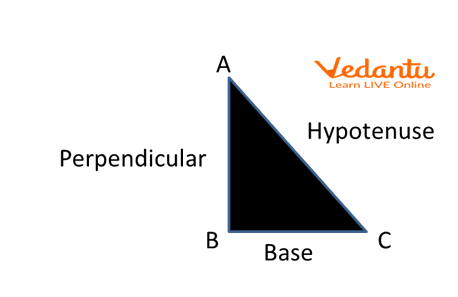
A Right-angled Triangle Demonstrating Pythagoras Theorem
Proof of Pythagoras Theorem
Graphical proof of Pythagoras theorem requires some construction as follows-
Steps 1- Prepare 8 right-angled triangles identical to each other. Keep hypotenuse as c unit and other sides as a unit of base and b unit of perpendicular.
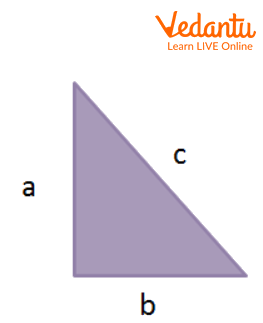
Right Angle Triangle That We Have to Draw 8 Times
Steps 2- Now construct two squares of side a+b.
Step 3- Now put four triangles in the first square and the rest four in the other square as per shown in the figure below.
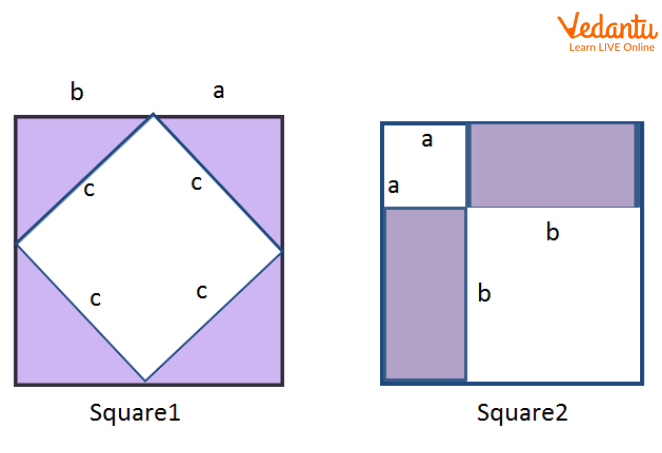
Two Identical Squares of Side a+ b
Observing both identical squares containing 4 triangles each are also identical, one can infer that-
The uncovered area of square1 is equal to the uncovered area of square2
Therefore-
\[c^{2}=a^{2}+b^{2}\]
This is the Pythagoras theorem i.e. the sum of the square of right angle triangle = square of the hypotenuse.
Pythagoras Triplet
Pythagoras triplet is a group of three positive integers such that they follow the rule given below-
\[a^{2}+b^{2}=c^{2}\]
Pythagoras triplets are denoted as (a,b,c) . for example- (20,21,29)
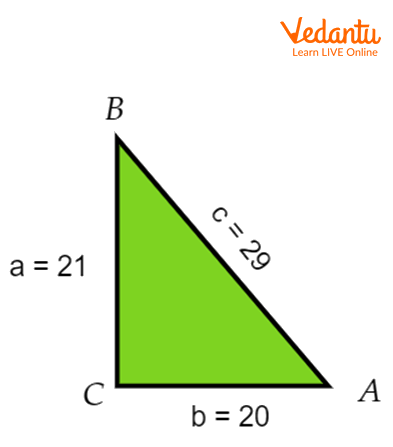
Demonstration of Pythagoras Triplet
Application of Pythagoras Theorem
We can use Pythagoras theorem as follows-
If two sides of the right angle are known we can find another side
We can check whether the right-angle triangle is possible or not from the given value of sides.
Interesting facts
If a triangle is following Pythagoras theorem then it must be a right triangle.
A straight line connecting the center point of the hypotenuse of a right-angled triangle to the right angle equals half the hypotenuse.
In a triangle, the longest side is the one that forms the greatest angle.
Solved Problems
Q1. Which of the following is Pythagoras triplet?
a) (3,4,5) b) (5,6,7)
Ans - a) \[5^{2}=25\] and \[3^{2}+4^{2}=25\]
So \[5^{2}=3^{2}+4^{2}\]
Hence it is Pythagoras triplet.
b) \[7^{2}=49\] and \[5^{2}+6^{2}=61\]
Hence (5,6,7) is not Pythagoras triplet.
Q2. We are given sides of triangles as (5cm, 12 cm, and 13cm). Find if this triangle is a right-angle triangle or not.
Ans- 13cm is the longest side so it is the hypotenuse and the rest are legs.
To be a right-angle triangle, it must follow Pythagoras theorem.
$13^2=169$ and $12^2+5^2=169$
Since this follows Pythagoras theorem hence this is a right-angle triangle.
Key Features
According to Pythagoras theorem -“Square of the hypotenuse is equal to the sum of the square of the other two legs of the right angle triangle”.
The right angle triangle is a triangle whose one of interior angle is 90.
Area of right angle triangle = \[\dfrac{1}{2}\times \text{base}\times\text{height}\]
Pythagoras triplet is a group of three positive integers such that they follow the rule given below- \[a^{2}+b^{2}=c^{2}\]
Practice Questions
Que- Find the area of the following triangle.
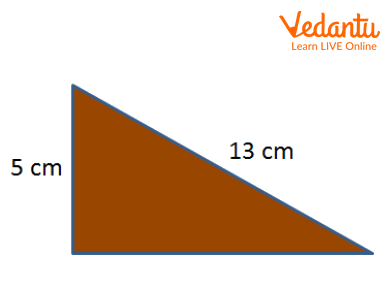
Practice Problem Figure 1
Ans - The answer is 30 \[\text{cm}^2\].
FAQs on Pythagorean Theorem
1. State the Pythagoras Theorem.
The Pythagoras Theorem states that “in a right angled triangle, the sum of the squares of base and perpendicular sides of the triangle is equal to the square of the hypotenuse side of the triangle”.
2. What is the formula of the Pythagoras Theorem?
In a right angled triangle, let the length of hypotenuse be ‘a’, the length of base be ‘b’, and the length of perpendicular be ‘c', then the formula of Pythagoras Theorem is given as Hypotenuse2 = Base2 + Perpendicular2, ie, a2 = b2 + c2.
3. Can Pythagoras Theorem be used for any triangle?
Pythagoras Theorem can only be used for a right angled triangle, ie, a triangle having one of the angles equal to 90 degrees.
4. What is the use of the Pythagoras Theorem?
Pythagoras Theorem helps to find one of the sides of a right angled triangle when the other two sides are given. It is also used to check whether or not a triangle is right angled. It can also be used to find the length of the diagonal of a square or a rectangle.
5. How does Pythagoras Theorem find if a triangle is right angled or not?
If the three sides of a triangle are provided then using the Pythagoras Theorem it will be possible to check if the triangle is a right angled triangle or not. Let's take two examples, one where the sides are given as 1cm, 2cm, and 3cm, and in another case, the three sides are given as 10cm, 24cm, and 26cm.
In the first example, the largest side is 3cm which, if the triangle is right angled, will be the hypotenuse. Therefore, let's check if the sum of squares of the other sides is equal to the square of this side. 12+22 = 1 + 4 = 5 but 32 = 9 which are not equal. Therefore, in the first case, the triangle is not right-angled.
In the second case, 26cm is the largest side, therefore, it is supposed to be the hypotenuse. Now let's check the squares. 262 = 676 and 102+ 242 = 100 + 576 = 676. Therefore, this triangle is right-angled.
6. Which is the largest side of a right angled triangle?
The square of hypotenuse is equal to the the sum of the legs of the right angle triangle. Thus the largest side of a right angled triangle is the hypotenuse of the triangle.
7. What is perimeter of a right angled triangle?
The perimeter of a triangle is the sum of all sides. The perimeter of a right angled triangle is base + perpendicular + hypotenuse.
8. What is the number of legs of a isoscles triangle?
The number of legs of a isoscles triangle is 2. The otherside of the triangle is known as base of the triangle.























